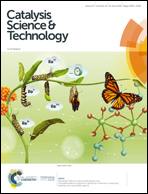Experimental and computational studies on copper–cerium catalysts supported on nitrogen-doped porous carbon for preferential oxidation of CO†
Abstract
Copper-containing cerium oxides are versatile and robust catalysts holding great promise for future market breakthroughs for preferential oxidation of CO in the applications of fuel cells. Carbon supports could improve the dispersion, redox properties, and geometric and electronic interactions of the mixed oxides for the goals of low-temperature activity and stability. We synthesized a series of CuCe catalysts supported on nitrogen-doped porous carbon supports for experimental analyses. The experimental results and DFT calculations show that there is a geometric interaction between copper and ceria species because of the incorporation of Cu ions into the CeO2 lattice. The primary type of N element in the NC support synthesized using a ZIF-8 template is pyridine nitrogen, which facilitates the adsorption and activation of oxygen. The high calcination temperature facilitates the reduction of copper oxide and leads to the enrichment of copper on the oxide's surface. The CuCe/NC-400 catalyst shows optimal catalytic performance due to the geometric characteristics of higher content of finely dispersed copper species and pyridine nitrogen and higher concentration of Ce3+ and oxygen vacancies, which together improve the synergistic effect between Cu2+/Cu+ and Ce4+/Ce3+ couples. The CuCe/NC-400 catalyst also shows good resistance to H2O due to the addition of nitrogen-doped porous carbon.



 Please wait while we load your content...
Please wait while we load your content...